Liverpool’s eHealth Cluster is hosting a series of workshops at iLinks 15, a conference bringing together leading innovators in healthcare. Based in the Digital Innovation Zone a few of the key companies who are part of the cluster, including Citrus Suite, Red Ninja, Digital Creativity in Disability and Damibu will showcase their products, IPs and ideas for supporting health and social care through technology.
In the first workshop we look at the potential of local SMEs and examine what’s already happening on our doorstep.
Hearing from;
Citrus Suite
Digital Creativity in Disability
Worpcloud
Damibu Ltd
Knowsley Health Hub
Liverpool’s eHealth Cluster is a group of health and social care SMEs working together to solve problems, we bring together technology companies, health and social care providers to create and share new ideas.
We provide a route into the “digital ecosystem” for SMEs to make sure they provide a key part of that and help people navigate through it. SMEs have to be represented; 1 in 2 workers in Liverpool city region relies on a SME for work. This is a very vibrant sector and Liverpool is the second fastest growing city for digital start ups. The aim of this first workshop is to give a quick snapshot of what they do.
We’ve been working on commercial apps since 2010, we’ve done a lot of exciting products for publishers like Random House and Penguin,. We are Creative England’s Future Leader for 2015.
We got into healthcare apps two years ago after enquiries from Pharma companies, healthcare providers and charities who wanted apps. One of the main has been ReMind Memory Suite, developed with Ljmu, Innovate Dementia and other partners. It is ready to go for trial but it has been a long process of co-design, taking it to a group of people living with dementia.
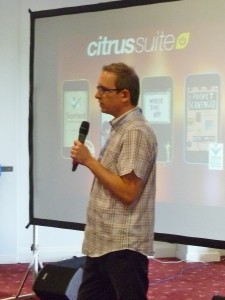
The app itself is a series of alert and reminders with social connectivity built in for families and carers. The co design sessions have been vital to bring those ideas back to the citrus suite studio.
There’s a clock at the centre of the app for the user, along with a speaking clock along with post-its, alerts and areas for social care professionals and family to use with alerts like “Make Breakfast”. I wanted this to be the type of app that if my dad gets dementia I could go in the App Store and find it; I want something my brother and I could use to coordinate care.
We have trials taking place with a lot of support moving forward, we’re working with Chinese Wellbeing , a social care company and the YMCA where we’re running trials with support from Liverpool city council.
Fee Fi Fo Fit is another app. I needed to get my kids out of the front door at the weekend. A lot of apps were being used already but not targeting kids. So we gamified walking an exercise. WE’re ready for trial and attracting investment.
We’re keen for collaboration and to talk about how to take the tech forward in a different direction, into learning disability, acquired brain injury, drug and alcohol issues. We want to make the most use of this technology.
Max Zadow, Digital Creativity in Disability
In the past I’ve worked at the BBC, Onteca making games and traditional apps. I set up on my own working in health and social care. The best advice I got was from fellow geeks and SMEs saying just go for it and being clever in how we use tech.
To create Support Space we had support from Innovate UK to do a project around Personal Budgets and worked with Worpcloud and Care Innovation. WE are one of the ten finalists for Nseta’s Inclusive Living Technology Prize.
WarnDry is an app we secured £100k from SBRI Healthcare to develop technology to predict, rather than alert, child bedwetting. We’ve a really good partnership within the ecosystem through Adrian McEwan, LJMU,. Damibu, Mi, NWC AHSN.
It’s all about the people and partnerships, that ecosystem working together with other SMEs, relying on them to get stuff done and that partnership pushes us forward.
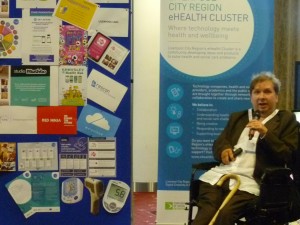
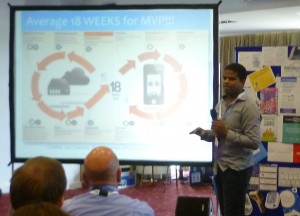
Bombarde Balde, Worpcloud
We are introducing our Backend as a Service, VStack.
It’s a platform and not a single app but allows developers to focus more on the UI and UX and forget the backend stack. Allowing user management, data storage, BaaS, infrastructure and platform APIs it allows you to spend just 10 weeks building an app, using 55% of the original effort if you had to build your backend.
We work on long term projects and build partnerships. My House of Memories is the app we are best known for. We began work on it two years ago and it is heavily led by people living with dementia. They knew what they were doing in real space, but wanted to take their ideas and bring it into the digital space.
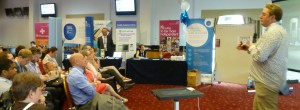
The key issues were app usability, people living with dementia were to be the main users of the app, getting the digital content in there and replicating the flow of reminiscence. A lot of House of Memories work is very hands on, staff listen to conversations and then provide prompts.
The app has won two European Wards with around 4500 people downloading it and are working with more museums across the UK.
My Cheshire East started as an internal Dragon’s Den, very open ended application with a wish-list of factors. The specification for the app was very large with a lot of different content coming in from all over the place. It provides a digital platform for people to access the council’s services and talk to them through an app on their smartphone.
Dr Jim Heath, Knowsley Health Hub
We are a typical training practice with 5300 patients. Last year we teamed up with a UI/UX designer with a background in gaming to develop our ideas.
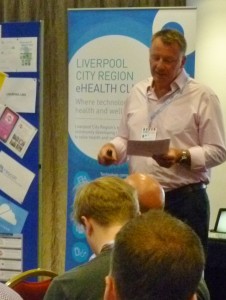
The motivation behind the platform was to tackle the coming tsunami of the ageing population. We know the conditions they will have and the resources they will need but there is no coordinated attempt to signpost that support. It needs a technical solution to do that. In Knowsley few services to support self care. especially from their own home. The resources that do exist are often out of date and largely intelligible to them.
We’re reaching the hard to reach; lifestyle choices are often hard for an individual to change. Working with the Knowsley Digital Inclusion Group. There’s an argument about costs and people having mobile devices. The template is for a one stop relevant lifestyle change and support application. The intention is to enable a change in behaviour; the habit to go to a mobile device is already embedded. We want to embed that habit, and provide regular and accurate health advice that’s right for them.
It will push relevant messages for age and gender and has to be engaging and to foster interaction. The system must be continually monitored and managed, real time citizen feedback and push messaging.
